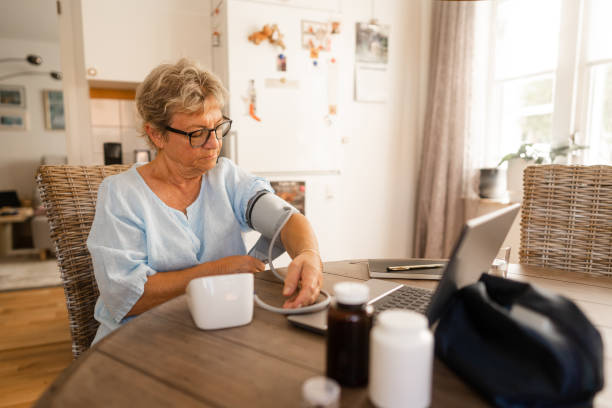Advancements in healthcare, particularly through remote patient monitoring (RPM) and the Internet of Things (IoT), are improving patient outcomes and cutting costs. For instance, Kaiser Permanente of Southern California found that only 10% of patients enrolled in a COVID-19 home monitoring program required hospitalization based on their symptoms. Remote blood pressure monitors transmit daily vital sign readings to healthcare providers. Data can be connected and transmitted via WiFi, Bluetooth, cellular, or a cellular-connected gateway.
The concept of IoT is broad but generally involves using technology for connectivity and data sharing. RPM and IoT enable biometric readings like blood pressure, heart rate, pulse, and blood glucose levels that automatically transmit to RPM platforms.
This article explores the impact of remote blood pressure monitoring on hypertension management, healthcare costs, and patient outcomes. It focuses on the role of the cellular-connected blood pressure monitor like the Tenovi BPM in advancing preventive care and enhancing the effectiveness of remote patient monitoring.
Hypertension and Cardiovascular Disease
Hypertension is a significant risk factor for cardiovascular disease. It affects 48% of all adults in the United States. However, accurately diagnosing and managing hypertension remains a challenge. Conventional clinic-based blood pressure monitoring can lead to inaccurate diagnoses, hindering effective hypertension management.
Remote blood pressure monitoring is a convenient and effective alternative. A recent study addresses the health and economic effects of adopting remote blood pressure monitoring among U.S. adults with hypertension, highlighting the potential of RPM blood pressure monitor technology.
Healthcare Costs Savings
A study published in the American Journal of Preventive Medicine analyzed myocardial infarction, stroke, and healthcare costs, considering the potential impact of remote blood pressure monitoring on the U.S. population. The findings showed that adopting home blood pressure monitoring could lead to a 4.9% reduction in myocardial infarction cases and a 3.8% decrease in stroke cases over 20 years compared to usual care. Additionally, transitioning to remote blood pressure monitoring could save $7,794 per individual in healthcare costs, showcasing the financial advantages of remote patient monitoring.
What is a Cellular-Connected Blood Pressure Monitor?
The Tenovi cellular-connected blood pressure monitor is specially designed for remote patient monitoring. It is a Bluetooth remote monitoring device that connects to the Tenovi Cellular Gateway. This technology makes a smartphone or app unnecessary for uploading patient measurements. Patients simply take their measurements, and the devices automatically send the measurements to their physician, streamlining the monitoring process. It even stores readings and re-sends them when a network is available.
Sensor Placement
Similar to traditional blood pressure monitors, a remote patient monitoring blood pressure monitor consists of two main components: a cuff and a sensor unit. The cuff is securely wrapped around the upper arm, and the sensor unit is either attached to the cuff or worn separately on the body, providing comfort and ease of use for patients.
Inflation and Deflation
The cuff inflates to a predetermined pressure level, temporarily halting the blood flow in the brachial artery. This pause facilitates accurate measurements of both systolic and diastolic blood pressures. Following inflation, the cuff slowly deflates, ensuring precise and consistent readings.
Pressure Detection
The sensor unit is equipped with advanced pressure sensors that effectively detect the pressure changes within the cuff as it deflates. These pressure sensors convert the physical pressure alterations into electrical signals, forming the basis for accurate blood pressure measurements.
Cellular-Connected Blood Pressure Monitor Signal Processing
The electrical signals generated by the pressure sensors undergo meticulous processing by the blood pressure monitor’s internal electronics. Through this analysis, the monitor determines the precise values of systolic and diastolic pressures, providing reliable data for medical evaluation.
Data Encryption and Security
The cellular gateway utilizes encryption protocols to maintain the privacy and security of the transmitted health data. These safeguards protect the information during its journey over the cellular network, addressing concerns related to patient data protection.
User and Healthcare Provider Access
Both users and authorized healthcare professionals can conveniently access real-time blood pressure readings. This access is facilitated through a remote patient monitoring dashboard, providing a user-friendly interface for monitoring and assessment. Historical data might also be available, aiding in tracking long-term trends and treatment efficacy.
Data Analysis and Trend Monitoring
Healthcare professionals harness the collected data to analyze trends comprehensively. With these insights, they can make informed decisions about treatment plans and offer valuable guidance to the patient, promoting personalized and effective healthcare management.
Tenovi Cellular-Connected Blood Pressure Monitor
Tenovi’s cellular-connected BPM is an FDA-cleared device with industry-leading accuracy. All Tenovi remote patient monitoring devices work right out of the box, eliminating the hassle of device setup.
Key features of the Tenovi RPM blood pressure monitor include the following.
- Measures systolic pressure, diastolic pressure, and pulse rate.
- FDA-cleared, CE, and EN certified with industry-leading accuracy.
- Large, easy-to-read digital display.
- Irregular heartbeat and body motion detection.
- Data is transmitted through a cellular network with the Tenovi Cellular Gateway.
Understanding the Cellular-Connected Blood Pressure Monitor
Remote blood pressure monitoring provides real-time data transmission and remote access capabilities. The shift from traditional clinic-based monitoring to more patient-centric remote blood pressure monitoring offers a paradigm shift in hypertension management.
Tenovi provides chronic care, telehealth, and remote patient monitoring software and services companies with intuitive and continuous real-time access to their patient’s health and billing data. This empowers health professionals with actionable information to guide and optimize patient care. Contact Tenovi today for a free demo and consultation.


